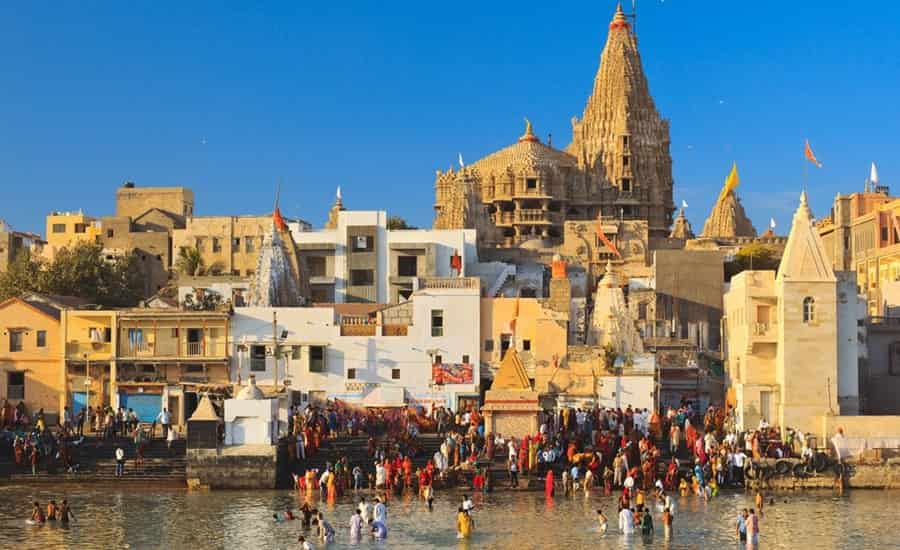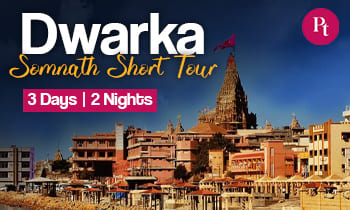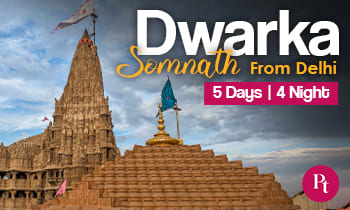Dwarkadhish Temple, dedicated to Lord Krishna, stands as a symbol of devotion and spirituality in the sacred city of Dwarka, Gujarat, India. With a rich history dating back thousands of years, this temple attracts millions of devotees each year. In this comprehensive exploration, we will delve into the intricate details of the temple’s timings and rituals, offering a glimpse into the spiritual tapestry that defines this holy sanctuary.

- Time Required: 1-2 hours
- Entry Fee: No entry fee
- VIP Darshan: Rs 300 to Rs 2000 based on the type of the Darshan.
Historical Background
The Dwarkadhish Temple, also known as the Jagat Mandir, holds immense historical significance. According to Hindu mythology, Dwarka was the capital of Lord Krishna’s terrestrial kingdom, and the temple is believed to have been constructed over the sacred spot where Lord Krishna once resided. The current structure, although renovated several times, maintains its essence as a revered pilgrimage site.
Timings of the Dwarkadhish Temple
- Darshan 6:30 AM 9:30 PM
- Mangal Aarti 6:30 PM
- Mangal Darshan 7:00 AM 8:00 AM
- Shringar Aarti 10:30 AM
- Sandhya Aarti 7:30 PM 7:45 PM
The Dwarkadhish Temple opens its doors to devotees at specific timings, aligning with the traditional Hindu schedule of worship. Understanding these timings is crucial for pilgrims seeking to experience the divine aura of the temple. The daily schedule is as follows:
Morning Darshan (Mangla Aarti): The temple opens early in the morning for the Mangla Aarti, a ritual conducted during the auspicious hours before sunrise. Devotees can witness the first darshan of the day and immerse themselves in the divine vibrations that permeate the temple during this sacred time.
Shringar Aarti: Following the Mangla Aarti, the Shringar Aarti takes place, adorned with the grandeur of dressing the deity with exquisite garments and jewelry. This ritual is a visual spectacle, captivating the devotees with the divine beauty of Lord Krishna.
Gopinath Bhog Aarti: The midday Aarti, known as the Gopinath Bhog Aarti, is an opportunity for devotees to participate in the offering of bhog (food) to the deity. This ritual symbolizes the bond between the devotee and the divine through the act of nourishment.
Sandhya Aarti: As the day progresses into the evening, the Sandhya Aarti marks the transition from day to night. The temple resonates with the melodious hymns and chants, creating a serene atmosphere for devotees to connect with the divine.
Shayan Aarti (Night Aarti): The closing Aarti, Shayan Aarti, is performed before the deity retires for the night. Devotees attending this Aarti witness the symbolic act of putting the deity to rest, concluding the day’s rituals with a sense of spiritual fulfillment.
Significance of Aartis
The Aartis conducted at the Dwarkadhish Temple play a pivotal role in the spiritual experience of the devotees. These rituals serve as a means of expressing devotion, gratitude, and surrender to the divine. The rhythmic chanting, accompanied by the resonating sound of bells and conch shells, creates a mesmerizing ambiance that elevates the devotee’s connection with the divine.
Rituals and Pujas
Apart from the regular Aartis, the Dwarkadhish Temple hosts various other rituals and pujas that devotees can participate in to enhance their spiritual journey. Some of the prominent ones include:
Abhishek: The ceremonial bathing of the deity, known as Abhishek, involves the pouring of sacred substances like milk, ghee, and water on the idol of Lord Krishna. This ritual signifies purification and the devotee’s desire to cleanse their soul in the divine presence.
Tulsi Archana: Devotees offer Tulsi (holy basil) leaves to Lord Krishna during this ritual, seeking blessings for health, prosperity, and spiritual well-being.
Raj Bhog Aarti: This ritual involves offering a royal feast to the deity, symbolizing the opulence and grandeur associated with Lord Krishna’s divine persona.
Dwarvesha Aarti: A unique ritual where the doors of the temple are symbolically closed to represent Lord Krishna’s departure from the mortal world. Devotees witness this ceremony with a sense of reverence and longing for the divine.
Chappan Bhog: The offering of 56 different food items to the deity, known as Chappan Bhog, is a grand ritual conducted on special occasions and festivals, signifying abundance and variety.
Festivals and Special Occasions
The Dwarkadhish Temple comes alive with heightened fervor and enthusiasm during festivals and special occasions. The temple witnesses an increased influx of pilgrims, and the rituals become even more elaborate and enchanting. Some of the major festivals celebrated at the Dwarkadhish Temple include:
Janmashtami: Commemorating the birth of Lord Krishna, Janmashtami is celebrated with unparalleled zeal. The temple hosts special Aartis, processions, and cultural events, attracting devotees from far and wide.
Holi: The festival of colors is celebrated with joyous fervor at the Dwarkadhish Temple. Devotees partake in the playful throwing of colors, symbolizing the joy and divine love associated with Lord Krishna.
Diwali: The festival of lights sees the Dwarkadhish Temple adorned with lamps and decorations. Special Aartis and pujas are conducted, creating a divine atmosphere of celebration and spiritual illumination.
Conclusion
The Dwarkadhish Temple stands as a beacon of spirituality and devotion, drawing pilgrims from various corners of the world. Understanding the temple’s timings and rituals is essential for those seeking a profound spiritual experience. The daily Aartis, special pujas, and festive celebrations contribute to the rich tapestry of traditions that define this sacred abode of Lord Krishna. As devotees immerse themselves in the divine energy of the temple, they become part of a timeless spiritual journey that transcends the boundaries of time and space.
Also Read:




 Call
Call WhatsApp
WhatsApp Enquiry
Enquiry